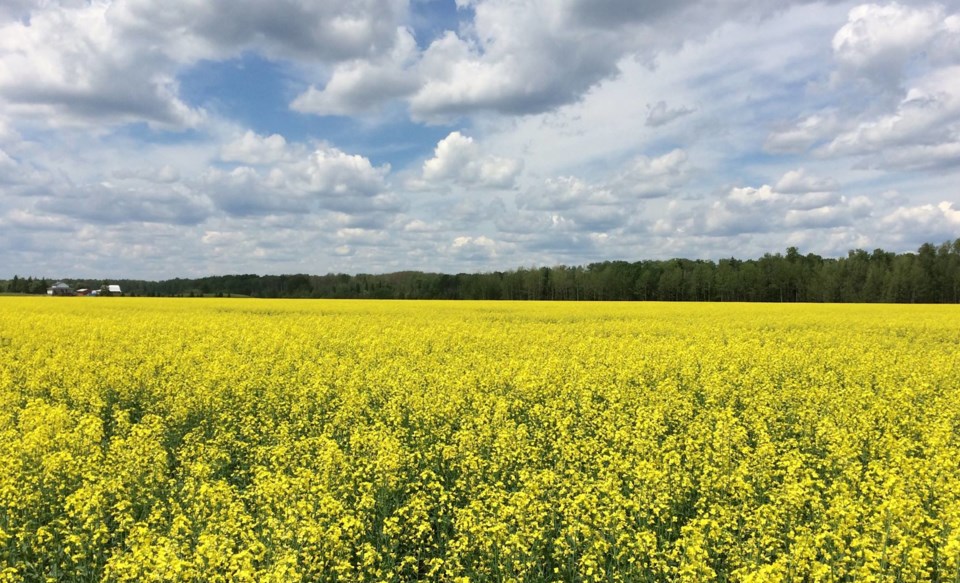Farmers and municipalities in the Great Clay Belt want to grow food, not trees.
Johanne Baril, mayor of Val Rita-Harty, believes this arable swath of land in the Cochrane District of northeastern Ontario can be recultivated over the next 20 years to feed Ontario and the world.
Farming was once a “thing of the past,” she said last week at the Municipal Agriculture Economic Development and Planning Forum in Temiskaming Shores, but climate change, unfortunately, is demonstrating “we can do it again.”
In recent years, there’s been growing interest in agricultural properties here from both newcomers and existing growers looking to expand their holdings on abutting lands.
“The more acreage they have, the better the numbers,” said Baril.
When compared to southern Ontario, the Clay Belt offers relatively lower land prices that’s resulted in a steady migration north from farmers seeking to expand their operations or completely relocate. The onset of climate change could mean longer growing seasons and more crop varieties.
The municipalities had wanted to help farmers put together land packages.
Problem was the 12 municipalities on the Clay Belt, including Val Rita-Harty, had no idea of what was available on the landscape, no details to provide to prospective investors and landowners.
“We looked like we don’t know what we’re doing on what’s out there in our community,” said Baril, who’s also the chair of the Northeast Community Network (NeCN).
Often underdeveloped or uninhabited land was held by non-farmers who lived outside the region. For confidentiality and privacy reasons, they could not provide any contact information from those owners considering offloading some property.
“Now we can,” said Baril, who presented on the results from NeCN’s Cochrane District Agri-Food Assembly Project, a database of available properties in the area.
To get the word out, the project involved contacting and interviewing various ag organizations, economic development officers, land-use planners, realtors and municipal and provincial officials.
Instrumental to their success has been the municipalities mailing out flyers to landowners, to go with the tax bill, to gauge their interest in selling or leasing and give permission to make that information public.
Those eligible to participate in the survey were those owners with more than 10 acres, and Class 1 to 4 soils.
Want to read more stories about business in the North? Subscribe to our newsletter.
Baril said the survey results were better than they expected.
One hundred and sixty landowners across the Cochrane District completed the survey in English, 17 in French. Updated every year, Baril said last year an additional 40 took the survey.
Through a GIS solution, Baril said they have an “incredibly complete” database with maps indicating where pockets of land are available, displaying the roll number, acreage, land classification, features like streams and pipelines, and the ownership.
The land assembly project is a first step towards tackling a longstanding issue among many in the Clay Belt: converting Crown land into private land for agricultural purposes.
These particular areas, once used for farming, have reforested over the years.
Though the idea is slow to gain traction with the province, Baril said this remains a topic of frustration. Decades ago, previous generations farmed the area, which reverted back to the Crown when agriculture declined.
“Crown land is definitely an issue. It’s top of mind always,” she said. “All we’re asking is for the land to be re-given.”
Baril thought it was a good strategy to first identify and quantify pockets of private land up for sale and before they begin identifying suitable Crown land.
She said they’re not talking of taking over huge areas of land on either side of Highway 11. “That’s not realistic.”
To that end, NeCN has crafted a business plan for developing more agriculture in the Clay Belt. The one-and-half-year exercise, she said, covers a policy shift with government and the outlines the tools needed to get that done.
Baril said they're mindful these undeveloped areas are not only Crown land, but are Indigenous traditional territory and are part of Crown forest management units used by the industry. But she believes there are synergies to be had, possibly in awarding compensation for forestry lands taken away.
“We think if the province does release Crown land it is to be done in a comprehensive way.
“We don’t want this thing to go sideways. We don’t want industrial farming in the North.”




